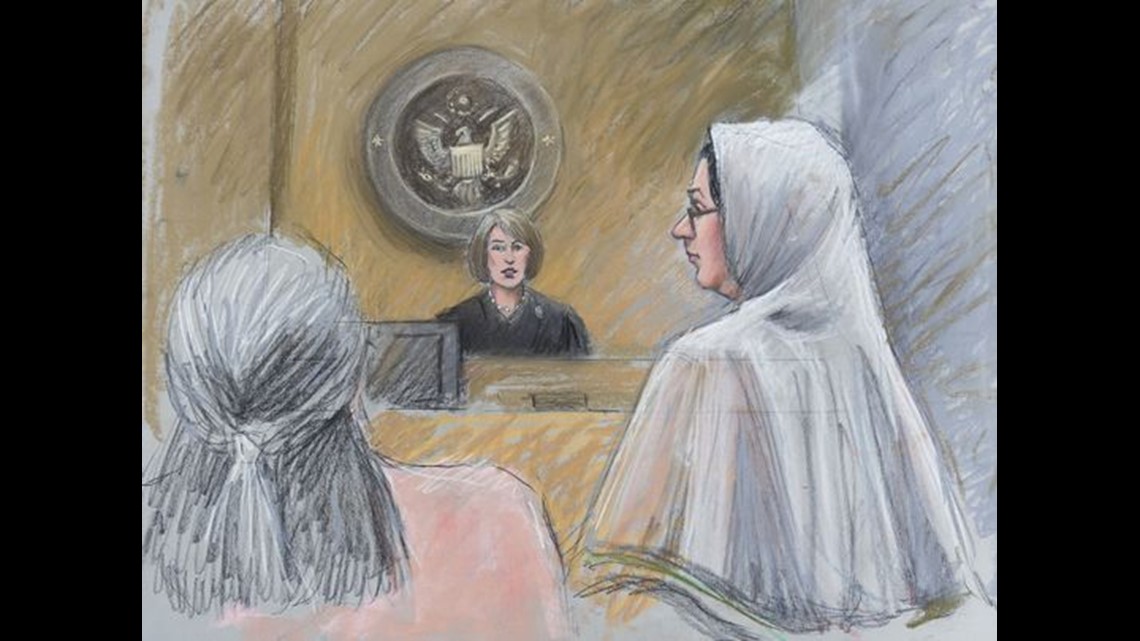It was the summer of 1990.
Mariya Taher was 7 years old, vacationing in India with her family, when one day her mother took her to a run-down apartment building without explaining why.
She remembers climbing some stairs, opening a door and seeing older women in a room. There was laughter, and the place seemed cheerful.
But then came the betrayal.
The child ended up on the floor. Her dress was lifted up.
“I remember something sharp down there and then I remember crying,” Taher, now 34, recalls. “I remember my mom comforting me afterward and holding me in her lap.”
A decade later, Taher would better understand what happened to her on that summer day in Mumbai. She had survived the taboo ritual of female genital mutilation, a decades-old religious tradition that millions of women worldwide continue to be subjected to, including a half million in the U.S., where a historic criminal case involving the practice is unfolding in Detroit.
In a first-of-its kind federal prosecution, authorities have charged three people for their alleged roles in the genital cuttings of two 7-year-old Minnesota girls at a Livonia clinic in February. Authorities say the girls came to Michigan with their mothers, thinking it was a special girls trip, but ended up having their genitals cut instead.
Dr. Jumana Nagarwala, 44, of Northville, who was arrested April 12, is accused of cutting the girls and, if convicted, could get life in prison.
Dr. Fakhruddin Attar, 53, of Livonia and his wife, Farida Attar, 50, were arrested Friday. He is accused of letting Nagarwala use his clinic to perform the procedure, while his wife is accused of holding the girls' hands to comfort them during the cuttings.
All three defendants belong to a small, Indian-Muslim community known as the Dawoodi Bohra, whose members say genital cutting is a deeply entrenched social and cultural norm, with some women viewing it as normal as having a period. Celebration parties are held after the cuttings, and the women and girls are supposed to keep it a secret. One of the key reasons for the procedure, victims say, is to curb a woman's sexuality.
Taher, who lives in Cambridge, Mass., grew up in the Bohra community in the U.S. and is closely following the Michigan case along with several other cutting victims who spoke to the Free Press last week about their painful pasts and the stigma of growing up feeling different, betrayed, ashamed. Like the victims in the Michigan case, they were told to tell no one about the cutting, that it was a special secret.
But the now-grown women are done being quiet.
After years of suffering in silence, fearful of getting shunned by their families and communities if they denounced genital mutilation, they are speaking out and demanding change. They want the cutters punished, along with religious leaders and parents who continue to support a practice that is illegal in the U.S. and has been condemned by the World Health Organization.


The Michigan case, they say, has emboldened them, particularly because the doctor's defense revolves around an all-too-familiar argument made by the Bohra community: that the mild, ritual "nick" or "shaving" isn't actual cutting. The victims disagree, they say, and they have the mental and physical scars to prove it.
“It's taken me a long time to be as comfortable as I am," said Taher, who hopes that her Sahiyo campaign to end female genital mutilation will gain momentum from the Michigan case. "We can’t have this happening ... Whether it’s a tradition, for religious reasons or for sex, I see all of it as controlling someone. This is a form of gender violence. It’s a form of child abuse. It’s oppression.”
Activists and world health leaders stress that genital cutting affects girls of all socioeconomic backgrounds and occurs in all parts of the world, not just in remote villages in Africa or Asia, but here in the U.S., too. To stress this point, the State Department this month released a video highlighting American survivors of female genital cutting, including a white American woman whose cutter, she says, was a fundamentalist Christian who mutilated her at age 3 to prevent her from masturbating later in life.
Coincidentally, the video was released on April 14, the day after the Northville doctor was charged in what would become the nation’s first federal criminal prosecution of genital cutting.
A shadowy figure
At 43, Alifya Sulemanji can still vividly recall the dark shadowy figure coming over her more than three decades ago.
It was a faceless old woman with a razor in her hand. She was 7, and her mother, an aunt and a cousin had taken her to an old building in a shady part of Bombay to — as they told her — “take a worm out of my body.” She remembers climbing some stairs and entering a dark, dingy room. Then the shadowy figure appeared.
“They just made me lie down and they started cutting me with a blade,” recalled Sulemanji, who remembers bleeding heavily and crying. “They told me, ‘Stop, stop. Don’t cry. Don’t tell anybody; this is a secret among women.’ ”
A woman then put black powder on her genitals, which stopped the bleeding.
“In my mind, I still feel the pain. It was very awful,” Sulemanji said in an interview Thursday with the Free Press. “I kept telling my mom — even now — ‘What on earth made you do this?’ “
“It’s our custom,” she recalls her mother telling her.
Sulemanji, who has a bachelor's degree in economics and sociology, grew up in India and moved to the U.S. at age 29, when she got married. She is a member of the Dawoodi Bohra community in Long Island, N.Y., and has two daughters, ages 13 and 9. There is no way, she said, that she would ever subject her daughters to the horror that she experienced at 7 — despite community and family pressure to do so.
"I know how it feels," she said. "It's a very cruel thing to do to a little girl."
Growing up in India, she was told that the practice was meant to “curb a woman’s sexual desire” so that a woman wouldn’t have an affair or premarital sex. The Bohras do this, she said, by cutting the hood — or tip — off of the clitoris, which was done to her. Today, she said, the Bohras are changing their story about why they practice genital cutting, claiming the ritual is for cleanliness and religious reasons.
Sulemanji associates it only with pain.
"When I grew older, it kept bothering me. I asked my friends, 'Did your mom do this to you?' But they never heard of things like that," she said, noting she learned that other Muslim sects in India didn't subject their girls to cutting, which angered her even more. "It was like my mom and dad cheated on me."
Two years ago, after learning about an Indian journalist who went public with her own story of genital cutting, Sulemanji decided to break her silence. In a bold move that stunned her Muslim community, she took to Facebook, along with her husband, and denounced female genital mutilation.
She was unfriended by many.
“It was burning inside. It had to come out," she said of her secret. "I want to punish all the parents ... I want to get all the cutters.”
Sulemanji has forgiven her mother, saying she is uneducated and didn’t know any better. Perhaps the most rewarding part of her activism, she said, is, “I convinced my mom that this is wrong. And she agreed.”
Sulemanji said the Bohra community restricts personal freedom and is more about uniformity, with rules about attire and proper beard lengths.
"We have a head priest who tries to control everything," she said. "This is like a cult. It just feels like we have a tyrant over us, a whole control thing going on."
But there’s still a lot of work left to be done, she said, noting the Michigan case.
“If this can happen in the U.S.A. — it needs to stop,” Sulemanji said, stressing the cutting leaves permanent scars.
“I remember everything,” she said. “It’s a bad, bad memory. It’s a scar on my life.”
A childhood secret
For nearly seven decades, A. Renee Bergstrom kept a dark, childhood secret to herself.
In 1947, in a small Minnesota town, her mother took her to see a doctor when she was 3 years old. Her mother, she later learned, had expressed concerns to the fundamentalist Christian physician that her daughter was touching her genital area, causing her face to get red.
"When she told the doctor, he said, 'Oh, I can fix that,' He removed my clitoris. And she knew immediately it was a mistake and told me to never talk about it," said Bergstrom, now 72.
For decades, Bergstrom did as her mother said. She told no one. Not her sisters, or her friends. At 15, she went on her own to see a doctor about discomfort she was having in her genital area, When the doctor at the clinic discovered she had been cut, she recalled, he gave her a book on the sin of self-pleasuring. She continued to keep quiet.
Bergstrom eventually got married and had three children. She had a very difficult time in childbirth and has never really known if her sexuality was affected, she said, noting: "How do you know?"
As an adult, she started researching and writing about what happened to her. She earned a doctorate degree in education and eventually joined other victims like herself in a movement to help end female genital mutilation worldwide. In December, she officially went public with her story and is featured in the U.S. State Department video about American genital mutilation survivors.
Bergstrom explained that her reason for going public had a lot to do with her concerns that Muslims worldwide are facing growing discrimination. She was worried that genital mutilation would be one more reason for people to show animosity toward Muslims, and so she shared her story as a non-Muslim.
"I'm a white Christian American, and this happened to me. And the doctor who did it was a fundamentalist Christian," Bergstrom said. "I remember the pain, and I remember feeling betrayed by the people who should have been caring for me."
Bergstrom said she has forgiven her mother. She trusted the doctor just like many other women have trusted their religious leaders who tell them genital cutting must be done for religious reasons, she said. While she believes doctors, religious leaders and parents should be held accountable for subjecting children to genital cutting, she doesn't believe children should be taken away from their parents, saying it "adds more trauma."
In the Michigan case, one of the Minnesota girls was temporarily removed from her parents. Bergstrom said she was relieved to learn the girl was given back to he parents. But the cutter, she said, needs to be prosecuted.
"It surprised me that somebody educated here in the United States, and who more than likely knew she was breaking the law, did it anyway," she said. "How strong is religion overtaking an oath to do no harm? ... I don't believe physicians should be doing that."
'A demonic practice'
She was 11.
Blindfolded, naked and with her hands tied behind her back, F.A. Cole was thrown into a circle of women who watched as a heavy nude woman amputated the girl’s clitoris as part of a ritual practice by many tribes in the west African nation of Sierra Leone. The cutter had been drinking and sat on top of her during the procedure. The girl put up a fight, so the other women gagged her.
“It’s really a demonic practice,” Cole, now 43, recalls, noting girls are sworn to secrecy. “They told us, ‘If you talk about it, you’ll die. They brainwash you … It’s a gross violation of our human rights.”
Cole’s younger years were full of more turmoil. She dropped out of high school and got pregnant. Sex was and remains painful. In 1997, she said, God intervened: She won an immigration lottery and moved to the U.S., where she has become a vocal activist in the fight to end genital mutilation worldwide.
In her freshman year in college in New York, she decided to go public with her story. She was attending a workshop on cultural issues when a speaker started talking about genital mutilation and referred to it as a religious practice for Muslims.
Cole, who grew up Catholic in Africa, said she knew better as her procedure was about tradition and a rite of passage, not religion. So she stood up and shared her horror.
“Everybody was silent,” she recalled. “I battled with it. I didn’t want to be judged. I was on a college campus in America for the first time. I didn’t know how they would take it.”
But she found empathy. And she has been sharing her story ever since, stressing that genital mutilation happens everywhere, to people from all walks of life. And whether people say it’s about religion, tradition, a rite of passage, she said, there’s one nagging truth: “It’s all about control.”
Cole now lives in Germantown, Md., with her 22-year-old son and mother. She’s a software trainer and activist. Her goal is to end genital mutilation everywhere.
“My hope is to continue sharing my story, talk about it and to educate women,” she said. “They need education. There’s really nothing good about FGM.”
Using scissors
In 2006, Khalid Adem, 41, became the first person in the U.S. to be convicted of female genital cutting. The Ethiopian citizen was found guilty in a state court in Georgia of aggravated battery and cruelty to children for using scissors to remove the clitoris of his 2-year-old daughter. He was sentenced to 10 years in prison. The case led to a state law that criminalized genital cutting in Georgia, one of 27 states that prohibits the practice. Michigan is not one of those states.
On March 13, Adem was deported to his home country of Ethiopia after completing his 10-year prison term.
A month after his deportation came the federal prosecution in Michigan, where the Dawoodi Bohra community has landed under fire for genital mutilation practices, which the group refers to as "khatna" or "khafd." It's not a first for the group.
In Australia last year, the Dawoodi Bohra community — which has 1 million members worldwide, including 12,000 in the U.S. — was at the center of a landmark female genital mutilation trial that ended with three convictions. An Australian court sentenced three people to 15 months in prison for carrying out the procedure on two girls.
Among the convicted were the girls’ mother, a retired nurse and a Dawoodi Bohra spiritual leader who was found guilty of helping the women cover up the mutilation.
The Australian case led to a crackdown in the U.S., where numerous Bohra communities issued resolutions instructing its members not to practice "khatna" on girls anymore because American law prohibits it. Communities in Detroit, Miami, Boston and New Jersey, among others, issued such resolutions, which warned parents "you are strictly directed not to engage in khafd." The groups also have warned members not to take their daughters out of the country for the procedure — known as "vacation cuttings" — citing a 2013 federal law that prohibits that.
On Friday, following the arrest of the doctor and his wife — the organization that oversees the Dawoodi Bohra community in Detroit issued this statement.
“The Dawoodi Bohras do not support the violation of any U.S. law, local, state or federal. We offer our assistance to the investigating authorities," the group, known as Anjuman-e-Najmi Detroit, said in the statement. "Any violation of U.S. law is counter to instructions to our community members. It does not reflect the everyday lives of the Dawoodi Bohras in America."
The organization, which has a mosque in Farmington Hills, stressed that it has issued a written statement instructing its members not to practice any procedures that could be construed as genital mutilation under federal law.
"It is an important rule of the Dawoodi Bohras that we respect the laws of the land, wherever we live. This is precisely what we have done for several generations in America," the group stated. "It is unfortunate if anyone has not abided by the laws of the country ... We take our religion seriously but our culture is modern and forward-looking. We are proud that women from our community have high levels of educational attainment and enjoy successful, professional careers.”
No anesthesia
Despite the calls for change, some people in the Dawoodi Bohra community are still afraid to speak out against genital cutting. One such couple lives in Dallas.
The Texas husband and wife, whose children are grown, are Bohras and say they have long been opposed to genital cutting. They did not subject their daughter to it, despite community pressure to do so, with some members suggesting they go to Chicago to get it done. But they're still afraid to express their views in their Bohra community of about 100 families, for fear of retaliation and being ostracized. Because of their fears, the Free Press agreed not to name them.
Both say the religious leaders in Dallas are powerful and wealthy and can make life very difficult for those who don't follow their rules. And despite these so-called resolutions telling members not to perform genital cutting, they say members in their community are still doing it. They say there's a go-to person in their community — a former pediatrician from India — who goes to people's houses and secretly performs genital cutting.
"We know that (members) are so blind in their beliefs that if the religious leader tells them to do (something), they do," said the woman, who is adamantly opposed to genital cutting given her own experience. It was done to her as a child nearly five decades ago in India.
"It was very very painful. No painkiller. No anesthesia. They just cut. I still remember the scissors. I remember it very very well," said the woman, who requested her identity be withheld. "They said it's for religion. We have to do it. No other reason, nothing."
But she has since learned, she said, that the elders were trying to suppress her sexuality. And she has no way of knowing, she said, if she's missing out on anything sexually, noting: "I don’t have the guts to ask some of my friends" about their sex lives.
As for the pain she endured, she said, "It stays in your mind for the rest of your life."
A matter of degree?
All three defendants in the Michigan case have denied any wrongdoing.
One defense lawyer believes the government has overstated its case, claiming no mutilation took place, and has accused the news media of sensationalizing and misrepresenting what really happened.
In court, Bloomfield Hills attorney Shannon Smith has admitted that her client — Nagarwala — performed a procedure on the genitals of two Minnesota girls. But it wasn't cutting, she said. Instead, Smith said, Nagarwala removed the membrane from the girls' genitals using a "scraper," wrapped it in gauze and gave it the girls' parents, who would then bury it following a religious custom.
Nagarwala has denied giving the girls shots or that there was bleeding, as alleged by the government. She also has denied participating in any genital mutilation procedures.
"All of the acts that my client performed on children" did not involve female genital mutilation, said Smith, arguing that "the issue of female genital mutilation presents vagueness."
"We understand that this is a very serious case," Smith said. But, she said, her client did not do what the government is accusing her of and has cooperated.
"It was completely a religious practice," Smith said.
The government has painted a much different portrait of Nagarwala, saying she performed female genital mutilation on several young girls over the years, directed them to keep it quiet and encouraged their parents to lie to authorities when investigators started asking questions.
"The conduct of the defendant spans years," Assistant U.S. Attorney Sara Woodward said in court, calling Nagarwala's crimes "heinous" acts that were part of an an "incredibly secretive" religious custom.


The government's investigation has relied on text messages, wiretap conversations, phone records and surveillance videos that authorities believe bolster their case. A Minnesota doctor also has examined both young victims — who told authorities about their visit to the clinic in separate interviews — and concluded that their genitals have been altered or cut, court records show.
"She knew that this was illegal, but did it anyway," Woodward said of Nagarwala, stressing: "As a medical doctor, she is aware that female genital mutilation has no medical purpose."
According to the World Health Organization, female genital mutilation is an internationally recognized violation of human rights of girls and women. However, more than 200 million girls and women alive today have been cut in 30 countries. The practice is most common in certain regions of Africa, the Middle East and Asia, though the U.S. is not immune.
The U.S. Centers for Disease Control and Prevention estimates that at least 513,000 girls have been cut or face the risk of being cut in the U.S., a roughly threefold increase from 1990, when 168,000 girls were deemed at risk or already victims of the practice. In 1996, Congress passed a law that made genital mutilation of girls under 18 a crime punishable by up to five years in prison. Seven years later, Congress passed another law that made it illegal to transport girls out of the U.S. for the purpose of cutting.
Since the passage of those laws, prosecutors in Detroit are the first to put them to the test.
The FBI has set up a tip line and is asking anyone who has information about female genital mutilation or the three Michigan defendants to call 800-CALL-FBI (800-225-5324).
Female genital mutilation
The World Health Organization has identified four types of female genital mutilation, which are based on the severity of the procedure. All are illegal in the U.S. and are internationally recognized as human rights violations of women and girls.
Type I, which is also called clitoridectomy. This involves the partial or total removal of the clitoris and/or the prepuce. Prosecutors say the Michigan case falls under this category.
Type II, which is also called excision. This involves partial or total removal of the clitoris and the labia minora, with or without excision of the labia majora. The amount of tissue that is removed varies widely from community to community.
Type III, also called infibulation. This involves the narrowing of the vaginal orifice with a covering seal. The seal is formed by cutting and repositioning the labia minora and/or the labia majora. This can take place with or without removal of the clitoris.
Type IV: All other harmful procedures to the female genitalia for non-medical purposes, for example: pricking, piercing, incising, scraping or cauterization.



